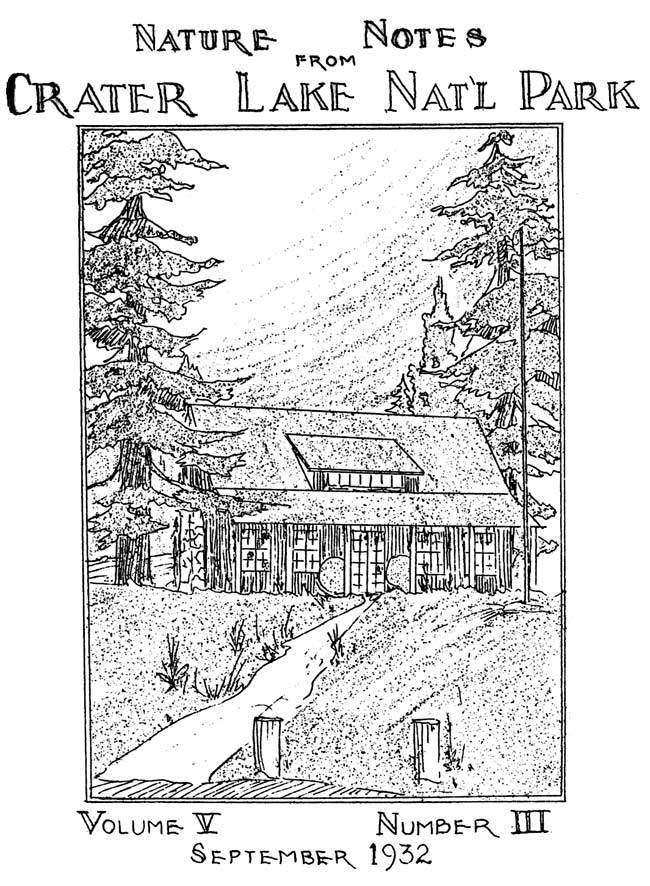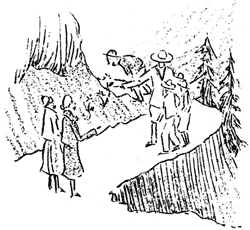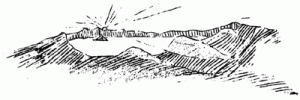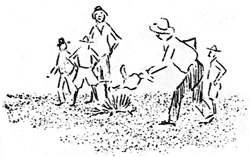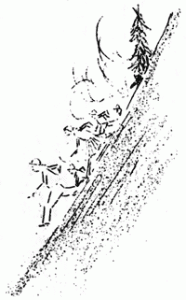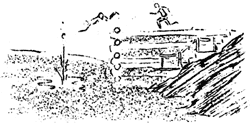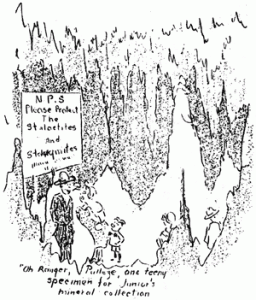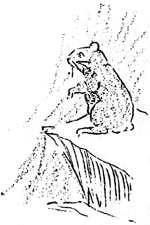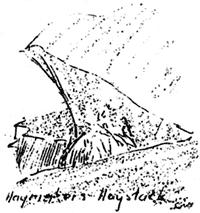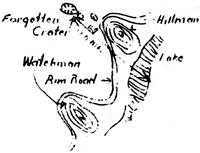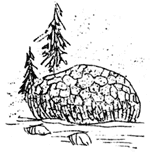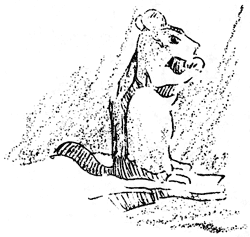Volume 5 No. 3 – September 1, 1932
All material courtesy of the National Park Service. These publications can also be found at http://npshistory.com/
Nature Notes is produced by the National Park Service. © 1932.
The Community House
By D. S. Libbey
The cover design shows the Community House at Crater Lake National Park. Many of you will recall the programs of song, music, informative talks and moving pictures. Our hosts, Rangers Ray Henderson and George F. Barron, are to be congratulated upon the very commendable character of the programs. This season the Community House programs began July 12. The excessive snow in the campgrounds prevented overnight campers until approximately that date and the last program of the current season was held on the night of September 16.
The purpose of the nightly programs is to enable each visitor to learn of the many features of the park. Below appears a copy of a letter written by a visitor of the past season concerning his stay at Crater Lake.
“My wife and I, with our boys, have visited thirteen of your national parks, several national monuments, and many state parks, — always with the idea of delving into their concealed recesses as well as obvious points of interest, to enjoy them to the utmost.
“So we strolled with Ranger Naturalist Constance up Garfield Peak and learned the names of your plants and flowers, and got a bird’s eye view of the terrain we planned to explore.
“We went several times to Sinnott Memorial to hear the story of the building up of the mountain, its destruction and the creation of beautiful Crater Lake from Mr. Count and Mr. Clark, — always fascinating and never in the same language, but always consistent, without poll-parrot repetition.
“We visited the Pinnacles on Wheeler Creek, recalling Bryce Canyon, yet distinctive. Saw the declining rays on the Sun Notch when Kerr was in shadow.
“On the way, leaving the park, we crawled through the ice caves of Llao’s Hallway, and got samples of rocks that float. Swam in the Rogue River at Natural Bridge.
“A deep impression will last of the splendid manner in which members of the Naturalist Staff aroused such understanding interest in the minds of the group at the Community House gatherings. Without scorn for our lack of knowledge concerning intricate scientific problems and without speaking in a condescending manner the lectures were delivered.
“Such is the way myself and family came to know and appreciate Crater Lake. We enjoyed our stay on the Rim; we must come back in the future to love it all again.”
Yours sincerely,
(Sgd.) a 1932 VISITOR
Cave
By Park Naturalist D. S. Libbey
The rediscovery of a cavern in the area of Crater Lake National Park is of considerable interest. It is located along the north exposure of the cliff midway between Mt. Scott and the lake, about three-fourths of a mile away from the Rim. The grotto is not one formed by the flowing of lava through a passage way, a lava tunnel, but is a cavity caused by the solution activity of ground water.
The cavern is about 200 feet long and extends backward into the cliff of andesite rock. The mouth is about 50 feet wide and from 7 to 8 feet high. The walls are covered in many places by stalactitic deposits. Curiously these cave deposits are not calcareous but are siliceous. It appears that the weathering action has caused the plagioclase feldspar to be decomposed and the resulting solution activity has caused the silica to be taken into solution and then to be deposited when exposed to the air. Many surfaces are covered with siliceous dripstone formations.
This cave was discovered during the current season by a group of workmen engaged in the Pine Beetle Control work. There is a story attached to this cave.
The story says that an Indian named Pedro years ago visited Linkville, now called Klamath Falls, and told of a very rich gold deposit he had discovered. Two Indians in the vicinity of Linkville followed Pedro back to the region and there found that in place of having discovered a gold deposit that Pedro had found two prospectors carrying very valuable sacks of gold. He murdered the prospectors and cached the stolen plunder in the cave. So goes the story, the authenticity of this seems to be varified by the fact that our park workmen found the cave in exactly the location described by an old Indian this current summer.
Facts, Fancies and Nebulous Thoughts
By Ranger Frank Solinsky
You have finished the geologist’s explanation of the cave — terse scientific facts as to its origin. But were you satisfied? Even the knowledge that the cave was comparable to a robber’s den does not offset the disappointment of disillusionment. The majestic awe and mystery of Crater Lake is conducive to fantastic thoughts and leads to the contemplation of ancient Deities, terrifying and sinister in their Aladdin-like ability to manipulate the mighty forces of Nature. To start, rumblings and movements in the bowels of the earth which end only with the destruction of great mountains and the complete obliteration of towns, cities and even races.
Let your fancy run wild — draw a picture in your mind of Dante’s “Inferno” — harken back to Vulcan. Possibly even now the bellows of his forge are breathing new life into this mountain and if we but murmur the magic words of Ala Baba, the rocks in the recesses of the cave will move and enable us to enter his workshop, far below the waters of the lake. Is this impossible? Does not this mountain exemplify vulcanism — lava flows, great dikes, cinder cones, and an immense caldera? Do not our Greek Mythologists go into elaborate detail in describing the entrance to Hades and furnish a map that will guide us through the intricate passages of the nether regions until finally we arrive at the Elysian Fields?
Give your imagination complete control and after a fascinating flight, arrive exhausted on the rim of the lake where suddenly the beauty and charm of the cliffs and the blue water will soften the tremendous forces and you will truly enter these Elysian Fields.
Haymaker
By Ranger Naturalist E. W. Count
An absurd little beast is the Pika or Cony (Ochotona f. fumosa).In front, he looks like a small rat; behind, his bobtail proclaims him a rabbit. As a matter of fact, he is the small cousin of the rabbit, and is not a rodent at all. If you gave him long ears, instead of those odd, little, mouse-like funnels, a rabbit he would immediately appear to be.
There are many of him in the rocks that jumble together at the foot of the slide that frowns at the boat-landing. The funny, whistling little bleat often maddens you because it does not always proclaim the whereabouts of its author. For the Cony minds his own business, and, unlike the Ground Squirrels, refuses to come to terms with the two-legged giants that run, tramp, or stagger and puff on the trail from shore to rim.
And why should he? – The two-legged animals have nothing to offer. Peanuts are for squirrels, but not for the bona fide cousin of rabbits. A Cony feeds on plant bodies, not on seeds.
Ray Telford, the “Admiral of the Crater Lake Navy”, reports that nothing can be more absurd than a Cony crouched comfortably, a long green stalk projecting far out from his mouth like the straw of the ruminating hill-billy, and the near end rapidly disappearing as those rabbit-cheeks munch solemnly. The stalk shrinks and disappears, leaving the Cony sitting there alone.
One article of diet surprised me. A little fellow was engaged in eating the full blossoms of the Lewis’ monkey flower. Earlier in the season a Cony was reported snipping off and rejecting the heads of sulfur flowers but cutting down and stacking the leaves and stems.
Under the rocks are the piles of hay. For this tiny buccolic engages in stacking the stems of many plants, that they may dry into hay in the crevices. On examining several such piles, I concluded that no kind of plant growing on the trail was rejected. There were, among others, fireweed, Lewis’ monkey flower, (these two with the blossoms still on them), some species of Rubus, false solomon’s seal, false hellebore, half an orange-skin, and even the black paper cup from a large chocolate cream!
Mystery at North Entrance
By Ranger R. P. Andrews
Creeping slowly up the shoulder of Mount Scott, the rising sun cast its first wan rays upon the slope of the northwest rim. The crest of the Rim was alive with a shimmering, opalescent light, for during the night the breeze from the north had stooped and brushed the earth with the summer’s first white frost. The breeze had died, however, and now the air was hushed and still. Even the lake, far below, lay motionless in the gunmetal shadow of Cloud Cap. Gradually the sun cleared the shoulder of Scott, and its warmth became perceptible. And then occurred a curious thing. I became aware of a murmuring as of leaves stirred by a gentle breeze, but the air was motionless. I walked to where a group of hemlocks stood, seemingly immobile. Standing beneath them I looked up, but not a branch moved, not a twig quivered. Still that rustling murmur continued, and the air remained motionless. I walked back to my original place and listened. It was fainter now. The rustling had sunk to the merest whisper. I strained my ears. The sound was gone. The sun was well up now, and I could hear the throbbing of a motor approaching from the Diamond Lake Junction. Puzzled, I walked back to the cabin for my permit book.
For two days I pondered that peculiar susurration, that rustling of leaves from invisible trees. And three chilly mornings I rose before sunrise to be at the Rim to hear it. On the third morning I solved the mystery – mere by accident than by logic. Again everything was silent; the air motionless and the lake without a ripple. Again the earth was white with frost. Then, as the sun rose, the same gradually increasing rustle commenced, seeming to rise from the ground itself. I sat staring vacantly down the slope of the Rim, wondering. A slight movement a few feet down the slope attracted my eye, but I was too slow to catch it. Again I stared at the ground, this time with purpose. Four feet before my eyes a pebble shifted and rolled over twice. Another. And another. The whole slope was in motion toward the Lake! The mystery was solved!
During the night tiny frost crystals had formed beneath these light pumice pebbles, raising them ever so slightly. The sudden heat of the rising sun melted these fragile supporting crystals instantaneously, and the pebbles dropped suddenly. Sometimes they would settle back into place, but more generally the abrupt shift of the pebble’s equilibrium, situated as it was on a steep slope, would cause it to roll downward for a distance varying from a fraction of an inch to as much as four inches. The infinitesimal sound produced by this process, when multiplied several thousand fold, had produced in its totality a sound resembling that produced by a breeze in the forest. And thus slowly, with infinite patience, Nature was making use of one of her varied tools to accomplish here work of wearing down the Rim.
Forgotten Crater
By Ranger D. LeC. Evans
To the geologist, that area traversed by the Rim Road presents a multitude of interesting features, all worthy of considerable study. Mazama Rock and the canyon at its base possibly deserves first place; the Hillman Pinnacles, Devil’s Backbone, Llao Rock, Cottage Rocks, and precipitous drop below Cloud Cap appeal to the inquisitive mind of the student of physiography; lastly, U-shaped valleys; masses of fill, polished and grooved rocks, are a temptation to the individual who is glacier conscious.
Possibly because of the major distractions, a very interesting feature has not been described or forgotten as the case may be. It is the purpose of this short sketch to briefly describe it and its importance. Additional work is essential before the newest of cinder cones can be described with any detail.
Located four tenths of a mile west of Hillman Peak, this crater can be seen as one rounds the north side of the Watchman. A flat hill, capped with red, it terminates the ridge that runs down from the Hillman Peak in a westerly direction.
This volcanic outlet consists of two craters. The main crater has an approximate diameter of 300 feet and a depth of about 75 feet, and a small subsiding crater to the east of the main outlets has a 50 foot diameter and only a slight depth.
Preliminary observations might be tabulated as follows:
1. The cone displays two types of cinder material, black and red. The black occurs at the base, particularly on the north side. The cone of red cinders has been erected stop the black, and there is an abrupt steepening in slope as one enters the red cinder cone.
2. Two types of lava were observed. The earliest is a gray, glassy flow rock which is perchance the equivalent of the Basic Andesite of Wizard Island. The latest is a rock showing excellent flow structure and is Dacitic in character, although it might be a Rhyolite when examined in thin section. This same rock without flow structure plugs the old outlet.
3. The cinders make up the north and east sides of the cone, the flow rocks form the south side and the western portion is open. Thus, the shape is that of a horse shoe.
Crater Lake National Park has been known for its adnate cones, its other smaller volcanic outlets existing as satellites about the base of an older and greater volcano. Red cone, 2.4 miles northwest of the water’s edge has always been considered the nearest. This cone (shall we call it Forgotten Crater) is by far the closest to the Lake area, being about eight tenths of a mile northwest of the Rim.
The Park area has always boasted of a simplicity of rock types. The write believed that this cone presents something that is not Andesite, Dacite or Basalt.
In conclusion, the case with which this point can be reached makes it quite attractive. Many people cannot make the more strenuous trips – to Wizard Island, Red Cone and Crater Peak, to investigate the signs of our most recent volcanic action. A short ten minute walk from the saddle behind Hillman Peak enables people to see a real cinder cone, contemporaneous in time, I believe, with that action which erected Wizard Island.
The Rejected Loaf
By Ranger Albert E. Long
Near a bridle trail about one mile southwest of the Cafeteria below the Rim of Crater lake is a large queer ovate boulder-like mass of lava covered by a crackled crusty surface. Indeed it looks very much like a huge loaf of bread that some giantress had left in the oven so long that the surface burned to a black crackled crust.
A geologist would at once proclaim it to be a huge volcanic bomb. A mass of viscid lava that had been hurled into the air during some explosive eruption of a one time active volcano. As this giant globule of molten lava whirled upward and through the atmosphere it became roughly spherical, under the strains of contraction generated by the cooling of the surface. The now hardened mass, nine feet in diameter and about eleven feet long, fell on the side of the volcano where it now rests. However, it may have been carried to the point where it has been found by a mountain glacier that existed on the slopes of the volcano in a past age.
There by the trailside it has lain for ages to be found by man. Some of these men call it a volcanic bomb, while others look upon it and are convinced that it must have been burned, and then tossed out the chimney by an indignant Vulcan who thought it was not fit to eat.
In Memoriam
By Ranger Naturalist E. L. Clark
Those of you who have visited Crater Lake National Park and have been a guest at the Lodge will remember little Oscar, the king of the golden mantled squirrels. Those who have not met Oscar personally may recall the picture postcard of a little sophisticated squirrel sitting on its haunches while eating a peanut that has just been offered by a friend. Oscar for the past two years has been the chief host at the Lodge, extending to all visitors a happy but wistful greeting. This spring he was sitting on the snow bank at the doorstep waiting for the early visitors to call. He prided himself in being able to tell a nut farther than any other squirrel. Being a privileged character, he was permitted to maintain both his private entrances into the hotel, one being near the grand fireplace where it was always so warm and cozy, and the other being near the postoffice window.
Many happy hours he spent on the knees of special friends, eating peanuts to his little heart’s content. His social register for the season included such friends as Captain Steel of the U. S. S. Saratoga, and Tom French, the famous football official of the Pacific Coast. It is rumored that the latter devised several reasons for extending his visit to Crater Lake, but the real reason was to feed the little monarch peanuts. In this he was duly rewarded when Oscar took 33 peanuts in succession.
These little friends in our national parks know no fear. They learn to trust everyone, even those who are leading a dog on a leash. While basking in the warm sunshine on the front steps of the Lodge, our little Oscar was suddenly seized. He felt severe pains rush through his tiny body, then he was shaken and everything became dark. Death had come fast. he never realized what had happened. Friends who witnessed the tragedy tell of a dog that rushed down upon the unknowing and unexpecting little monarch, driving the life from the little body with one vicious crunch of his powerful jaws. The dog had been carelessly tied to the wheel of an automobile.
In ceremonies befitting the occasion the remains of the golden mantled squirrel, Oscar, were cremated in the fireplace that he had learned to love.
Friends, help us protect our wild animal life.
Other pages in this section


